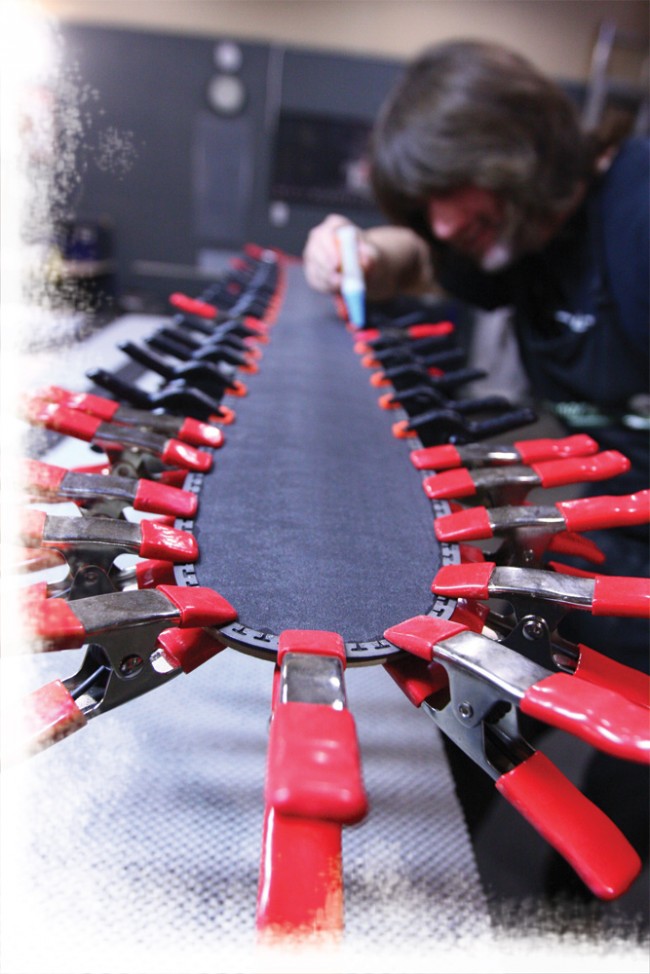
Photo Credit: Photo Amanda Follett
The Art and Science of Ski Making
James Fisher’s shop is a thing to behold. It dwarfs his house in downtown Smithers and is immaculate, despite the faint smell of epoxy.
“We bought the shop—the house came with it,” he jokes.
What also came with the 1,400-square-foot shop was the opportunity to pursue his passion. After years in the ski industry, Fisher decided it was time to stop working on other people’s skis and develop his own. A couple years ago, a WorkBC grant allowed him to quit his job as a ski tech and begin developing his own business: a line of skis called Paranormal.
This impressive backyard business isn’t just where he makes skis—it’s where he’s making them better.
“Dust is your enemy,” Fisher explains when I comment that the shop rivals a hospital for cleanliness. Particles can create bubbles in a ski’s top sheet. “Everything has to be pretty clean during the setup.”
Having the space, he notes, is also important: skis are cumbersome and their production tends to take a lot of space. Also unwieldy is the 1,500-pound ski press that he made himself with some online research, a 40-foot I-beam and a high-pressure fire hose.
Innovation is just one ingredient that goes into Fisher’s meticulous ski production.
First, the science
Fisher begins by designing his skis on a computer program. His first pair, the Weapon, he says he agonized over, creating four prototypes and changing the molds several times. He holds up a sheet of numbers: combinations of woods and profile settings that he has been experimenting with.
The ski’s core is made with local birch and aspen from a nearby mill, which he binds using a pine-based epoxy—a byproduct of the pulp-and-paper industry. Then he experiments with the physics: some woods are stiffer than others and how the ski performs depends on how the wood is layered within the core. The right combination creates rigidity or flex in different parts of the ski for a response that suits the conditions.
This might be a good time to mention that the multi-talented Fisher also has a background in cabinetry and fine woodworking.
Once the core is complete, it’s protected with plastic seals around the edges and tip spacers at the front and back. For each model, the ski’s specific design—side cuts, rocker and camber—is tweaked depending on the weight of the skier and the intended terrain.
“Because I’ve sold and tested skis for a long time, you get a pretty good idea what works,” he says. “By testing things back-to-back in a variety of conditions you get an idea of the nuances.”
Fisher isn’t just innovating skis: he also creates the right tools for the job. When a tool proves inefficient or simply doesn’t exist, he has one made or creates his own from materials in the shop.
“This is an example of how you come up with the more advanced tools—you cobble things together with junk,” he says, holding up a tool he made for creating the edging’s curve along the nose of his skis.
It doesn’t look at all like junk—it looks like just the right tool for the job.
Before the ski is sandwiched together, a vibration-dampening rubber is added to create less wear on the ski during use and each pair gets a layer of tri-axially braided fibreglass and stringers of carbon fibre, known for its excellent strength-to-weight ratio, under the top sheet to make the skis lighter and stiffer.
Then the materials go into Fisher’s coffin-esque ski press, where they cure at more than 80 C for 25 minutes. Once cooled, the skis are trimmed with a jigsaw.
Interchangeable molds allow him to use one press for a variety of ski sizes and types, and will enable him to manufacture snowboards and split boards in the future.
Fisher recently ordered a high-end inline belt and stone grinder, as well as an edge grinder. These tools—the only ones of their kind in northern BC—create a high-quality base and edge finish, and he now does as much ski tuning as ski building on downhill skis, cross-country skis and snowboards unavailable anywhere else in the North.
Then the art
Any skier knows that while performance is important, first impressions also matter. Fisher doesn’t just have the technical side down—he also creates his skis’ graphics.
That’s right: the scientific woodworker is also artistic.
For his first prototype, he digitized an acrylic painting he’d done several years earlier of Gimli Peak in the Valhalla Range. For his second graphic, he experimented by playing with images of aliens that he’d imported into Photoshop.
Buying a drawing tablet allowed him to design directly onto his computer. A graphic for his second prototype, the Pack of Wolves (which he fondly refers to by its acronym, POW), is a detailed drawing of a wolf slinking menacingly from the shadows. It’s “a little bit creepy,” he admits.
“I watched a documentary about Yellowstone that said the wolves struggle through the summer and as soon as the snow starts to fly they come alive and become the dominant species in the park in the winter. It sort of spoke to me,” he laughs.
Once completed, he emails the graphic to a supplier who sends it back as a top sheet. He also plans to make a wood-veneer ski as well as a ski that exposes the wood core.
Finally, the skiing
Once the ski is pressed and trimmed, there’s one final step: peeling a clear protective film from the top sheet—an unveiling of sorts. Fisher gives me the honour.
“It’s a very good feeling when you get to that point—it’s finally done,” he says.
As the frosted plastic peels away, revealed beneath is a glossy top sheet with vibrant colours—this one boasts Fisher’s original Gimli Peak painting. I grip the ski’s narrowed waist, feeling its almost weightlessness in my hand and sharp edges against my fingers.
The ski I’m holding, the Weapon, is a fat backcountry ski with lots of rocker and camber at the centre. The POW is a narrower version of the Weapon and great for spring skiing, groomers and harder snow conditions. His third ski, the UFO, is a freestyle ski. All are tailored to local ski conditions.
It’s easy to understand Fisher’s ear-to-ear grin as he admires his work. While he spent the first winter working on his prototypes and the second year putting his research into the community for testing, this year all three models are available to purchase. The skis, which retail for about $900, are simply continuing a high-quality ski-making tradition here in Smithers, Fisher says.
“There’s a whole history here of building skis that I find really interesting,” he says. “You can tell when you go out into the community there’s still such a passion for it.”
For more information or to order skis, visit the Paranormal website at www.paranormalskis.ca




